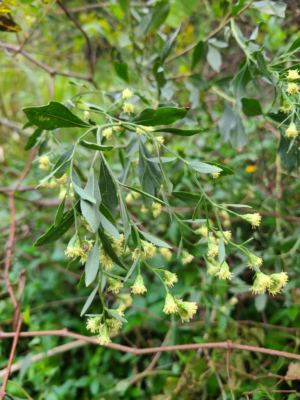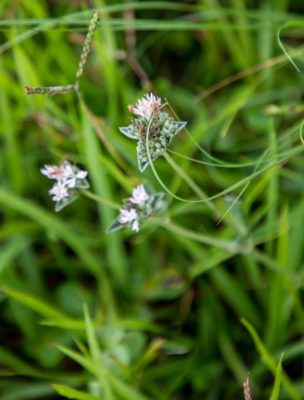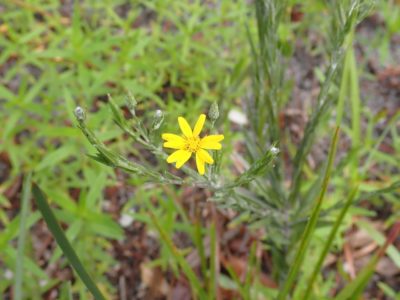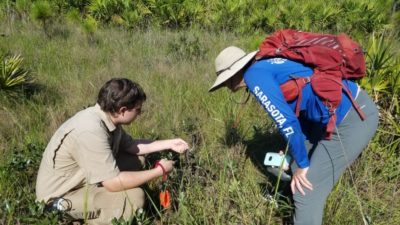
Baccharis halimifolia (Photo by: Sandra Robinson)
Baccharis halimifolia (groundsel tree), is a fall-flowering, multi-stemmed shrub that is not always recognized as being in the Asteraceae family because it can reach tree size. While more commonly shrub-sized, they can grow to 12 feet high and comparably wide. They have gray-green, shallowly lobed, oval leaves. Their snowy-white flowers bloom in numerous small, compact heads on terminal inflorescences. The plants produce male and female flowers on separate plants (termed “dioecious”).
The flowers produce abundant nectar that support a variety of pollinators, including the monarch butterfly. The fluffy, white profusion of seeds released from the female plants in late fall make it look like it is snowing in Florida. This salt tolerant species is normally found in wetlands, marshes, estuaries, and the inland shores of coastal barrier islands making it an excellent ornamental shrub for the Sarasota-Manatee County area.

Elephantopus elatus (Photo Credit: Sandra Robinson)
Elephantopus elatus (tall elephant’s foot) is an herbaceous short-lived perennial. The flower gets its name for the rosette of flat, basal leaves that can resemble the shape of an elephant’s foot. The erect 2-foot flower stem terminates in flowerheads that are surrounded by three leaf-like bracts that are hairy and deltoid in shape. This aster bears no ray florets, and the small disk florets can be pink, white, or lavender. This plant is a friend to pollinators, including bees, tachinid flies, and butterflies. This native species can be found in flatwoods, sandhills, mixed woodlands, wet prairies, and rural areas. It is a great addition to wildflower gardens and habitat restoration sites. Like many asters in Florida, it is a seasonal bloomer flowering in the fall months August through November.

Mikania scandens (Photo credit: Sean Patton)
Mikania scandens (climbing hempvine) is a twining vine that blooms with flat-topped clusters of white to pinkish flower heads. It is commonly seen blooming in the Florida fall climbing atop other plants, creating dense mats over thickets of shrubs and small trees. It has heart shaped leaves that are arranged in pairs along the stems. It will die back in the winter, assisting in its own self-containment. It attracts a number of pollinating insects and is a great choice for butterfly gardens, native landscapes, and habitat restorations. Hempvine is one of the most common asters seen along lake shorelines and is common in many community lakes and wetlands.

Pityopsis graminifolia (Photo Credit: Sean Patton)
Pityopsis graminifolia (narrowleaf silkgrass) is a native perennial herb not to be confused with a grass as its common name suggests. Its leaves are linear to lance-shaped with silvery hairs, and can appear grass-like. The inflorescence (flower cluster) contains bright daisy-like yellow flowers and can range from a few to many dozens of flower heads and typically bloom in late summer into fall. The flowers attract a variety of pollinators making it a great addition to a native or xeric landscape. This plant thrives in poor to well-drained soils and the foliage will spread into a small mat which can be used as a groundcover and is easy to establish and maintain.

Please join our EcoFlora Project on iNaturalist and create your own citizen science account. We want to see what is growing in your backyard and neighborhood! If you are interested in joining us on a BioBlitz this month please choose which date and location work best and register with the provided link below. We cannot guarantee dry feet but we can provide the opportunity to examine and observe the local fauna and flora that contribute to the unique ecology of our Florida habitat.
Click the link to register:
Curry Creek Preserve BioBlitz– October 27nd 9-12pm
Little Manatee River Southfork Tract– October 29th 9-12pm
